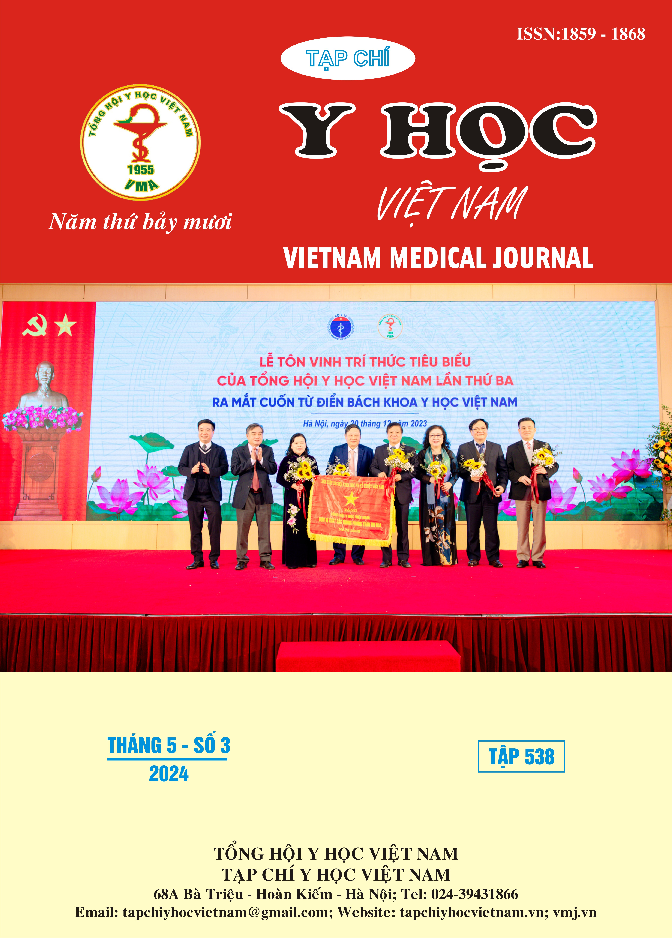SHORT-TERM OUTCOMES OF DISTAL PANCREATECTOMY WITH SPLENECTOMY AT K HOSPITAL
Main Article Content
Abstract
Objective: To evaluate the early outcomes of distal pancreatectomy with splenectomy (DPSS) for the treatment of pancreatic body and tail lesions. Subject and method: A retrospective observational study was conducted on patients who underwent DPSS at the Department of Hepatobiliary and Pancreatic Surgery, K Hospital from November 2020 to February 2024. Results: A total of 26 patients were included in the study. The mean age was 53.7 ± 16.9 years, and the female-to-male ratio was 2.25:1. Epigastric pain was the most common symptom, reported in 20 patients (76.9%). CA 19-9 was elevated in 6 patients (23.1%). The mean tumor size on computed tomography (CT) was 5.1 ± 2.5 cm. Preoperative biopsy was performed in 5 patients (19.2%). The majority of patients had soft pancreatic parenchyma (53.8%). Pancreatic transection was mainly performed using a stapler in 16 cases (61.5%), and reinforcement of the pancreatic cut surface was performed in 21 patients (80.8%). Resection of adjacent organs was performed in 3 patients (10.7%). The mean operative time was 133.8 ± 43.4 minutes. The majority of postoperative pathological results were malignant, with 12 cases (46.2%). Two patients had lymph node metastasis (7.7%). A total of 19 complications (73.1%) occurred, including pancreatic fistula (57.7%), all of which were grade A; post-operative pancreatitis (7.7%), abdominal effusion (3.8%), and post-operative bleeding (3.8%). Fifteen patients (57.7%) experienced post-operative complications, mainly grade I (53.3%) according to the Clavien-Dindo classification. The mean length of hospital stay was 9.4 ± 2.8 days. Conclusion: DPSS is a surgery that should be performed in specialized centers. The most common complication is pancreatic fistula.
Article Details
Keywords
Distal pancreatectomy with splenectomy, pancreatic body and tail lesions
References
2. Clavien P-A, Sanabria J R, Strasberg S M (1992), "Proposed classification of complications of surgery with examples of utility in cholecystectomy", Surgery, 111 (5), pp. 518-526.
3. Nguyễn Hồng Phúc Đ H L, Phan Minh Trí, Đoàn Tiến Mỹ, Nguyễn Thị Thùy, Nguyễn Thị Thủy, Dương Thùy Linh, Trần Thị Bé Thi, Nguyễn Phương Kiều (2023), "Đánh giá biến chứng sau phẫu thuật cắt thân đuôi tụy theo phân loại Clavien-Dindo", Tạp chí Y học Việt Nam, 527 (Tháng 6. Số đặc biệt), pp. 46-55.
4. Trịnh Hồng Sơn (2013), "Kết quả phẫu thuật ung thư biểu mô thân đuôi tụy tại Bệnh viện Việt Đức giai đoạn 2002-2011", Tạp chí Y học thực hành, 875 (7), pp. 32-38.
5. E Poruk K, Z Gay D, Brown K, et al (2013), "The clinical utility of CA 19-9 in pancreatic adenocarcinoma: diagnostic and prognostic updates", Current molecular medicine, 13 (3), pp. 340-351.
6. Gorris M, van Bodegraven E A, Abu Hilal M, et al (2024), "Outcomes after distal pancreatectomy with or without splenectomy for intraductal papillary mucinous neoplasm: international multicentre cohort study", British Journal of Surgery, 111 (1), pp. znad424.
7. Đỗ Hoài Kỷ P M T, Võ Trường Quốc, Đoàn Tiến Mỹ, Phạm Hữu Thiện Chí (2019), "Kết quả sớm phẫu thuật cắt thân đuôi tụy bảo tồn lách", Y Học TP Hồ Chí Minh, 23 (1), pp. 150-153.
8. Yoshioka R, Saiura A, Koga R, et al (2010), "Risk factors for clinical pancreatic fistula after distal pancreatectomy: analysis of consecutive 100 patients", World journal of surgery, 34 (1), pp. 121-125.
9. Nguyễn Thành Khiêm Đ H Đ, Trịnh Hồng Sơn, Nguyễn Hàm Hội, Lại Thanh Tùng, Lương Tuấn Hiệp, Nguyễn Thị Lan, Lê Văn Duy, Đặng Kim Khuê, Nguyễn Ngọc Hùng (2021), "Cắt khối thân đuôi tụy - lách xuôi dòng triệt căn: Thông báo lâm sàng và điểm lại y văn", Tạp chí y học lâm sàng, 121, pp. 7-15.
10. Kleeff J, Diener M K, Z'graggen K, et al (2007), "Distal pancreatectomy: risk factors for surgical failure in 302 consecutive cases", Annals of surgery, 245 (4), pp. 573-582.


